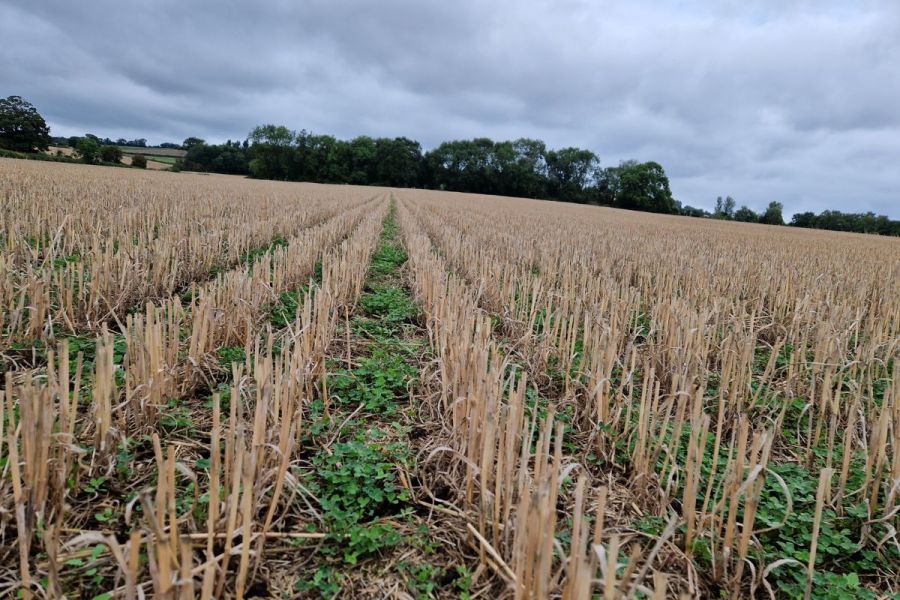CPM returns to Overbury to find out how the clover understory has fared and how planting plans have changed as farm manager Jake Freestone makes ‘on the hoof’ decisions because of the dry conditions.
“At the moment I still feel that a clover understory is the way forward here, especially as integration with the livestock is really important.”
By Lucy de la Pasture
Striding across the stubble with a fork characteristically tucked under his arm, Overbury farm manager Jake Freestone strides towards the two white sticks that mark the site of his most recent experiment. There’s a smattering of micro-clover plants sitting between the rows of stubble but it’s fair to say the drought has severely punished the once promising understory.
Just two months earlier, it was an entirely different picture. There was a carpet of green under the crop of Champion winter wheat, poised to take over once the wheat towering above it was harvested and provide some free grazing for the farm’s flock of sheep. But scorched by record temperatures and suffering from the absence of rain, all that remained after the combine was shrivelled up plants, says Jake.
Gesturing to a small patch of green which stands out amongst the golden hue of the stubble, he explains: “I wanted to see if the clover would regrow when it eventually rained so I’ve been watering this plot with a watering can.”
Jakes spears the soil with his fork and uproots a nearby clover plant, dropping to his knees to bury his nose into the soil he’s cradling in his hands. “The roots are growing. Look at all these white roots coming,” he says, evidently with some relief.
Although the rest of the field is somewhat behind, only just beginning to feel the benefits of some September rain, it’s alive and greening up. But it’s not enough to fatten lambs on as planned and Jake has accepted this disappointment and puts the lack of autumn grazing down to the season.
Even though the understory hasn’t provided the instant cover crop for grazing he was hoping for, it does have wider business benefits, he explains.
“It’s amazing how much water the clover took out and that’s potentially one of the risks, but it could also be a benefit. Taking moisture out of the ground through the autumn is not a bad thing as drilling gets later and the clover also acts as a ‘mattress’ which helps carry farm machinery,” he says.
But it’s the nitrogen-fixing abilities of clover that are also part of the attraction for establishing an understory, theoretically reducing dependence on nitrogen from the bag. So did it fulfil that expectation? Jake’s pretty pleased with performance of the seed crop of Champion winter wheat, which received a reduced rate of nitrogen compared with the farm standard.
“We applied 133kgN/ha in total and the yield was 10.93t/ha, which is good for this land. With a gross output of £2951/ha (seed wheat at £270/t) and variable costs coming in at £510/ha, the gross margin works out at £2441/ha,” he says (see table on page xx).
A delve into Gatekeeper reveals the detail behind the nutritional support given to the crop, which is based on SAP analysis, soil mineral nitrogen testing and Yara N-tester readings in the crop.
“Soil mineral nitrogen and the amount that’s available to plants (soil nitrogen supply) is so important. Last season crops came out of the winter with a good supply of residual soil nitrogen, but the dry spring added a layer of complexity.
“I’m a biological farmer and soil biology needs moisture and warmth to get it going in the spring. Without both of those things, the biological functioning of the soil doesn’t happen.”
At Overbury, only 14mm of rainfall was recorded during April – the month where wheat starts to motor through its growth stages and nitrogen is required to support that growth. “We actually put some foliar N on because the Yara N-tester indicated the crop needed it and it couldn’t get it from the soil because of the dry.”
Jake believes the changing weather patterns will affect his management strategy next year. “We’ve had a run of five or six dry springs so frontloading of N is something to look at and top up with a minimal amount later in spring,” he says.
Having given up on its grazing prospects, with no time left on the clock to achieve enough of a canopy to graze off before drilling, Jake says the understory has recently had 5t/ha of well-rotted FYM. But because the sheep won’t be nipping it off, will there be too much bulk when it comes to drilling?
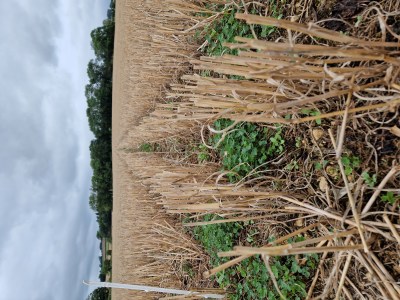
As the clover understory shrivelled after harvest, Jake has been watering a trial plot by hand to see whether the plants would recover.
Jake assesses the line of clover lying in between the rows of stubble. “I think when we apply glyphosate to take out the fat hen and groundsel growing here, and any cereal volunteers, it will knock the clover sufficiently so it’s not competitive with the crop. We’ll probably bring the drill over a bit so the coulters are running in between the stubble and that should encourage the clover to move outwards into where last year’s crop was growing,” he says.
With a full season’s experience of a clover understory under his belt, what’s Jake’s view on its value? “At the moment I still feel that a clover understory is the way forward here, especially as integration with the livestock is really important. We’ve established another 17ha this year – two of the fields look quite well but the third is less good and is under quinoa, which we’re yet to harvest.
“I want to take the opportunity to establish clover where I can and there’s a 14ha field up on the hill that isn’t wanted for hand-picked peas next year. My plan is to give it a spring fallow with a grazing cover crop and then into clover,” he explains.
“We’ll plant a multi-species mix of oats, vetch, forge rape, stubble turnips, linseed and mustard. It will cost around £40/ha, but I think we’ll be short of forage this winter which makes it a valuable crop to us. Our stubble turnips have gone in later than normal after waiting for 9mm of rain but it’s still almost too dry.”
The cover was planted using the farm’s Horsch Sprinter drill which Jake finds useful for establishing cover crops in autumn because of the slight amount of soil movement caused by its retro-fitted, super-slim 12mm Metcalfe coulters. It’s also cheaper to run than the farm’s Cross Slot, with fuel consumption when pulling the Horsch at 5 l/ha compared with 15 l/ha for the Cross Slot, says Jake.
“We applied 20kgN/ha as the crop was emerging and a further 30kg/ha when we knew we had a crop.”
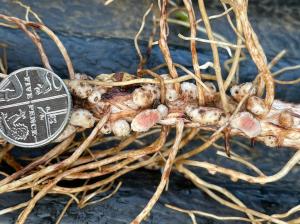
Last year’s bean crop had well-nodulated roots after the soil was primed with a forage rye and vetch catch crop, but this year it’s been too dry to adopt this approach.
Another impact of the summer drought on the farm has been to drastically curtail the planting of catch crops, which Jake says need a minimum of a five-week window before planting the cash crop. So this year he’s reined back on any fields where he felt it would be too dry for catch crops to grow, also bearing in mind the costs of seed and fuel.
“I don’t think missing one year will be vastly detrimental. We’ve chopped all of our straw so it’s shielding the soil surface from the sun and the wind, which is one of the principles of regen agriculture,” he says.
Perhaps the most significant catch crop loss is the one that was destined to go in front of the winter beans. “We would normally plant a mix of forage rye and vetch, which acts as a primer by activating soil bacteria. The winter beans would then go into pre-stimulated soils – when the nodule-forming bacteria will be looking for another legume host.”
Even though he’s not able to adopt this tactic this autumn, Jake isn’t tempted to use an inoculant on his seed. “In last year’s crop the beans had very healthy and numerous nodules, and they were active as they were red inside when cut open. It’s a good indicator of soil health but it will be interesting to see whether there’s a difference in nodulation this season – although any observations will be anecdotal as there are so many variables that could affect it.”
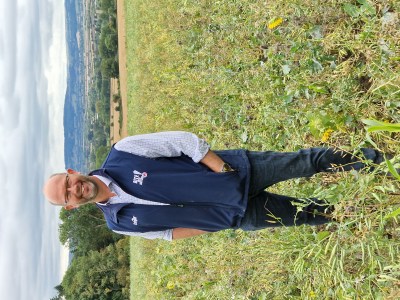
Jake Freestone plans on growing 25% more beans this year, partly because he’s abandoned winter linseed after two disappointing years, but mostly because the drought has caused a rethink on the farm’s planned 160ha of OSR, which has now been reduced to 65ha.
Jake plans on growing 25% more beans this year, partly because he’s abandoned winter linseed after two disappointing years, but mostly because the drought has caused a rethink on the farm’s planned 160ha of oilseed rape, which has now been reduced to 65ha as some fields were just too dry to plant.
“We had 45ha planned on the Evesham series soil, but the seed would just have disappeared down the cracks. On the sand and gravel land, the 9mm of rain we had didn’t warrant the cost of the seed and diesel to chance getting it in,” he says.
But there are positives to the change in plan. “Beans are huge soil improvers and have done well here for the past two years, so we’re swopping OSR for beans which are much lower cost to grow. Direct drilling with the Horsch Sprinter has given us more consistent establishment and has also helped with weed control as the Metcalfe points don’t move as much soil as other openers.
“We haven’t needed to use any glyphosate pre-harvest for the past couple of years as crops have been cleaner,” he notes.
Further up the hill, Jake hops over the electric fence that’s now surrounding the 12-species cover crop that had just been established when CPM visited in early July. Now a jungle about three foot high, with smiling sunflower heads dotted throughout, the sheep haven’t got far from where they were turned into the field a few days ago. Most of them resting, the scene is reminiscent of an all-you-can-eat buffet, with a few loosened belts before getting up to go again.
Jake points to the fodder radish which has had a good season and has been the most successful of the species in the mix. “That’s why it’s such a good mix, the growing conditions suit different species and this year the radish has done really well. I think I may have left it a bit late, it’s a bit peppery so I don’t know if the sheep will like it,” he says.
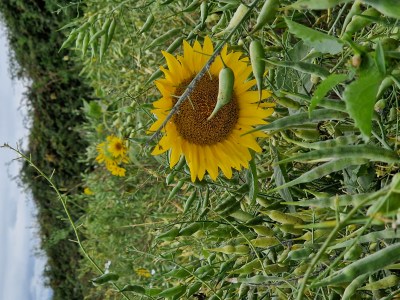
Pods of peppery fodder radish and sunflowers form part of the sheep’s all-you-can-eat buffet in this multispecies cover crop.
As he splits open a pod to reveal the white fleshy seeds, you know that titbit of information would have been gained from first-hand experience as, odds on, Jake would have tasted the pods.
There’s noticeable insect and bird activity in and around the crop, with groups of linnets darting between the cover of the crop and the hedge. “Yesterday there were loads of swallows in here. There’s plenty of food around,” he says, pointing out some mealy aphids crowded on the tops of the fodder radish, with butterflies and other insects also easy to spot.
Stooping to pick up a sunflower head that’s on the ground, Jake breaks it open to reveal the rows of shiny black seeds – apparently something that’s a bit of a prize in the all-you-can-eat buffet. “When we first turned the sheep out into a cover with sunflowers in, they left them until the very end. But when we moved them, they went straight for the sunflowers, literally munching their way around the heads. They have to learn about new plants when then haven’t had them in front of them before,” he says.
Hopping back over the fence, Jake walks to the field below, which is the top of the field with the clover understory he was looking at earlier. He points to a patch of green, where the clover is thick and juicy looking, standing high above the stubble. “See that damp patch in the field, that’s what it could be like,” he says, giving grounds for his optimism for its grazing potential in future seasons.
Ascending still further up the hill, there’s some hope that the farm’s sheep may have some alternative grazing in a few weeks, which would take the pressure off the grassland and allow it to recuperate before winter. Here cover crops have been planted as part of the Showcase trial being run by Dr Amelia Hood at Reading University.
Three different cover crop mixes were planted in mid-August for the field-scale trial, with a fallow as control. It’s part of the EU Horizon-funded Showcase initiative, which is quite literally showcasing synergies between agriculture, biodiversity and ecosystem services in 15 different European countries to help farmers capitalise on native biodiversity.
Jake says the idea is to assess the winter hardiness of different species with the aim of reducing reliance on glyphosate for cover crop destruction, as well as assessing earthworm activity and rooting depth in the different treatments.
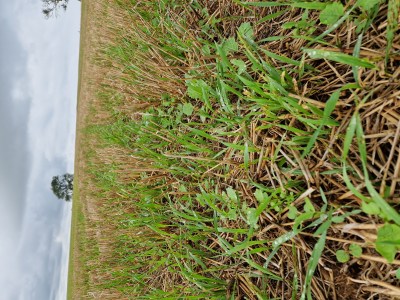
OSR has got away with a little September rainfall – guarded by its companions, berseem clover and vetch. Barley volunteers have just been sprayed off.
Walking across the treatments he notes winter linseed in one strip has established well and ponders on why it’s not so easy to get going when planted as a monocrop. “Perhaps it does better with other species around it,” he says.
Nearing the top of the hill, which reaches 1000 feet (305m) at its highest point, the soil becomes distinctly brashier. The OSR planted here a few weeks ago is looking undamaged and with 3-4 true leaves, has got past the stage when it’s most susceptible to cabbage stem flea beetle. Standing guard around the plants are its companions, vetch and berseem clover, and the barley volunteers have recently been sprayed off.
“We’ve put in a hybrid, DSV Darling, because of its good autumn and spring vigour. Because of the high stone content up here, we normally only get around 50% establishment. We planted 42 seeds/m2 with the aim of getting 20-25 plants/m2,” he explains.
“We’ll give the crop a nutritional boost shortly, with phosphite to encourage rooting and some foliar AF Pulsar (S, Mg, Mn, Zn, Cu, B, Mo and Co).”
All in all, this harvest has been a reminder that the climate is changing. “Although harvest was an easy one, it was stressful for everyone because of the fire risk. The stress was multiplied by supply chain issues which meant that if the combine went up, the capacity to replace it wasn’t necessarily there,” says Jake.
“We’re open access here, with lots of footpaths and permitted rights of way, so we all have to take on board the potential risks, and not just as farmers but the general public too.”
Quarry South Field
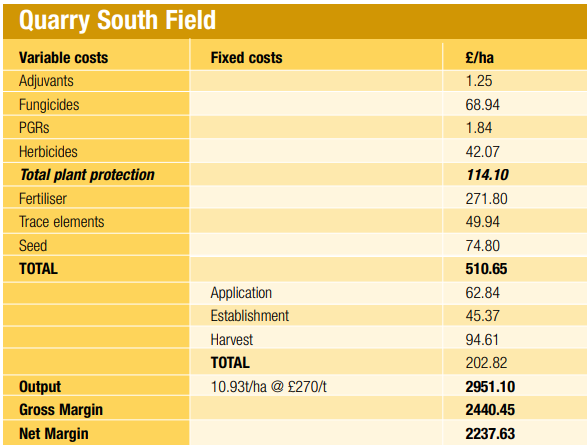
Source: Overbury Enterprises; Gatekeeper records 2021-22
This article was taken from the latest issue of CPM. For more articles like this, subscribe here.

